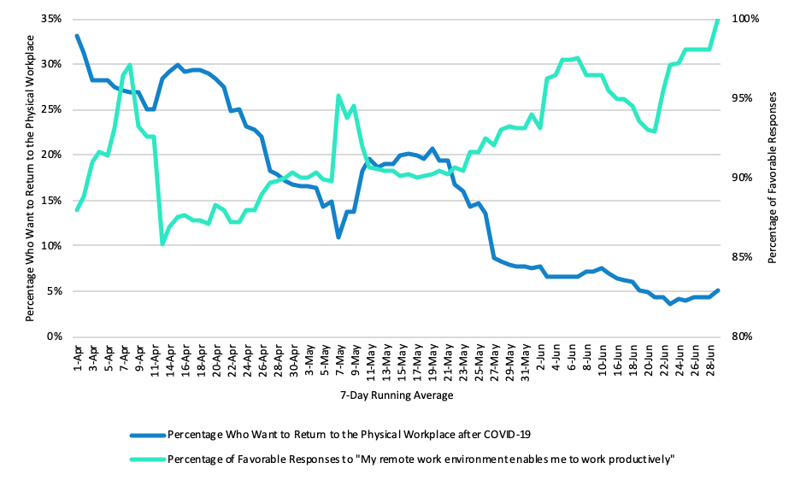
Employees Become More Productive Working from Home, they are Less Likely to Want to Return to the Physical Workplace After COVID-19

During our May 7th Insights Discussion, we shared that just 30% of employees wanted to return to the physical workplace after the COVID-19 pandemic. We continue to track changes in workplace preferences during the pandemic, and we have recorded a significant shift that has strong implications for organizations:
- The percentage of employees who want to return to the physical workplace after COVID-19 has declined precipitously from its peak of 33% in the beginning of April to its trench of just 4% at the end of June. Clearly, employees are not eager to return to the physical workplace. What is behind this shift in workplace preference?
- Improvements in personal productivity when working from home is strongly and inversely related to the desire to return to the physical workplace. For many, the newness of “working from home” has now shifted to the familiarity of “living at work.” Employees have had the time to create a suitable remote working environment and mastered remote work tools. In addition, companies such as Twitter and Facebook have announced that employees now have the option of working from home permanently, and will provide funds for work-from-home supplies such as ergonomic office chairs, standing desks, and dual monitors. The combination of the growing experience with remote work and the additional flexibility and resources made available from managers and organizations has increased the percentage of favorable responses to “my remote work environment enables me to work productively” from 86% to nearly 100%.
Other societal factors clearly have an impact on the decision to work remotely or in the workplace. The landscape of COVID-19 continues to shift. States and cities have reopened with mixed success. Given the recent sharp increase in cases, many employees are worried about a second wave and want to limit their exposure to unnecessary risks that might come from returning to the physical workplace.
What new trends are on the horizon? We saw a considerable shift in scores for productivity and desire to return to the physical workplace near the end of May; productivity jumped, desire to return plummeted. This shift coincided with the end of the school year, a time when many working parents and caregivers were freed from home schooling responsibilities. The return to school in the fall is uncertain, especially given the recent surge in COVID-19 cases. Undoubtedly, school decisions will impact parents’ willingness and even ability to work in the physical workplace. It is possible that we will see the reverse shift in data patterns (productivity decline, desire to return to workplace increase) as the school year approaches.
Employees report that they are productive, but are they really? Companies must temper this self-report data with additional, objective metrics of productivity. If the company’s results, as measured by sales, profits, customer satisfaction and more, are stable or up, then it is fair to say that remote work is working. Having said that, a central workplace with colocated employees provides many benefits to the organization, such as the opportunity to brainstorm, collaborate, and build a sense of unity and culture. As with any trend, time passing and the collection of more data will continue to shed light on work preferences.
Want to know how your people are doing during this unprecedented time?Perceptyx has created several short pulse surveys specific to the pandemic. These surveys include the ability to measure your people’s needs over time and compare to external benchmarks as they become available, and will allow access to real-time insights related to shifts in needs across their organization. |